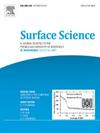Destruction of surface oxide on (100)W in high-temperature atomic carbon deposition
IF 2.1
4区 化学
Q3 CHEMISTRY, PHYSICAL
引用次数: 0
Abstract
Sequential adsorption of oxygen and carbon on the (100)W surface was studied in a wide temperature range at T = 900–2100 K. Surface tungsten oxide WO is formed upon oxygen adsorption at T = 300 K. Carbon deposition with atomic flux on surface oxide at T = 900–1100 K results in the replacement of the surface oxide by surface tungsten carbide, and this process requires a double carbon dose compared to that required to create the surface carbide on the atomically clean tungsten surface. Oxygen leaves the surface, apparently, due to the formation of CO molecules, which thermally desorb at this temperature, and carry away not only oxygen, but also half of the deposited carbon. The oxygen-free adsorption centers are simultaneously filled with newly arriving carbon atoms, which build the surface carbide WC.

高温原子碳沉积(100)W表面氧化物的破坏
在T = 900 ~ 2100 K的较宽温度范围内,研究了氧和碳在(100)W表面的顺序吸附。在T = 300 K时,氧吸附形成表面氧化钨WO。在T = 900-1100 K的温度下,用原子通量在表面氧化物上沉积碳会导致表面碳化钨取代表面氧化物,与在原子清洁的钨表面上生成表面碳化钨相比,这一过程需要两倍的碳剂量。氧离开表面,显然是由于CO分子的形成,CO分子在这个温度下热解吸,不仅带走了氧,而且带走了一半的沉积碳。无氧吸附中心同时充满新到达的碳原子,形成表面碳化物WC。
本文章由计算机程序翻译,如有差异,请以英文原文为准。
求助全文
约1分钟内获得全文
求助全文
来源期刊

Surface Science
化学-物理:凝聚态物理
CiteScore
3.30
自引率
5.30%
发文量
137
审稿时长
25 days
期刊介绍:
Surface Science is devoted to elucidating the fundamental aspects of chemistry and physics occurring at a wide range of surfaces and interfaces and to disseminating this knowledge fast. The journal welcomes a broad spectrum of topics, including but not limited to:
• model systems (e.g. in Ultra High Vacuum) under well-controlled reactive conditions
• nanoscale science and engineering, including manipulation of matter at the atomic/molecular scale and assembly phenomena
• reactivity of surfaces as related to various applied areas including heterogeneous catalysis, chemistry at electrified interfaces, and semiconductors functionalization
• phenomena at interfaces relevant to energy storage and conversion, and fuels production and utilization
• surface reactivity for environmental protection and pollution remediation
• interactions at surfaces of soft matter, including polymers and biomaterials.
Both experimental and theoretical work, including modeling, is within the scope of the journal. Work published in Surface Science reaches a wide readership, from chemistry and physics to biology and materials science and engineering, providing an excellent forum for cross-fertilization of ideas and broad dissemination of scientific discoveries.
 求助内容:
求助内容: 应助结果提醒方式:
应助结果提醒方式:


